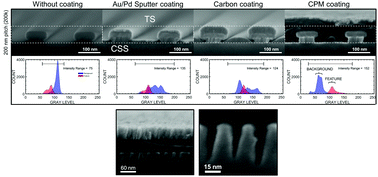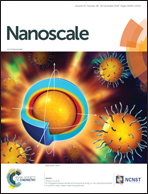Polymer–metal coating for high contrast SEM cross sections at the deep nanoscale†
Abstract
In scanning electron microscopy (SEM), imaging nanoscale features by means of the cross-sectioning method becomes increasingly challenging with shrinking feature sizes. However, obtaining high quality images, at high magnification, is crucial for critical dimension and patterned feature evaluation. Therefore, in this work, we present a new sample preparation method for high performance cross-sectional secondary electron (SE) imaging, targeting features at the deep nanoscale and into the sub-10 nm regime. Different coating architectures including conductive and non-conductive polymer, carbon and metal are compared on their ability to discern etching feature profiles and materials interfaces of densely packed nano-patterned features. A stacked coating of polymer and metal produced better visibility mainly due to enhancement of contrast between feature and background. Contrast was evaluated by using histograms of intensity of gray levels directly derived from SE images, obtained by the SE in-lens detector. In polymer–metal coatings (PMC), optimization of contrast is explored by varying the thickness of the metal layer and results are discussed in terms of the effectiveness of the metal layer in reducing the escape of secondary electrons (SE) generated in the polymer layer and feature. Other advantages of PMCs are their cleanroom compatibility and ease of coating removal.



 Please wait while we load your content...
Please wait while we load your content...